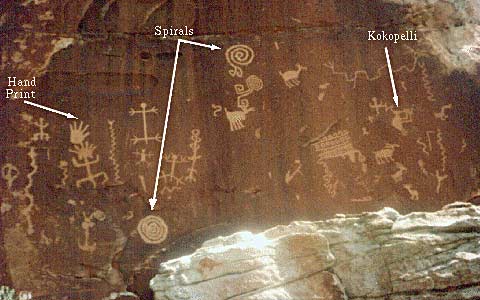

The little figure that leads you through these pages is based upon a figure commonly found in petroglyphs and pottery throughout the southwest. He is thought to be a symbol of fertility. His image is found from Casas Grandes in Mexico to the Hopi and Rio Grande Pueblos and westward to the California deserts. The pecked in images vary considerably, but he is generally depicted as a hunchback, usually playing a flute and sometimes with male genitals of exagerated size. The figure has been found in pithouse ruins dated as early as 200 AD and in petroglyphs as recent as the 16th century, dated from their association with images of men on horseback.
It has been speculated that the figure originally derived from traveling traders who announced their arrival by playing a flute as they approached, as is still done in Central America. It is well documented that trade routes were extensive throughout the region. The bodies of parrots Maxwell Museum online exhibition) that had been ritually buried are found in Anasazi ruins. Shells that must have also come in along these trade routes are also commonly found at these sites.
The figure is known as Kokopelli because there is a hunchbacked kachina at Hopi of that name who also plays a flute. The Hopi say that the hump contains seeds of all the plants in the world, thus extending the association with fertility. At other pueblos there are varients on this story, i. e. the bag contains songs to be exchanged for other songs.

I made these drawings in the spirit of the wandering peddler, bring music and gifts from elsewhere and perhaps carrying a new perspective on the lives of others in his hump. I gave him a few other instruments, as well, as his numbers grew. To the figure I added a handprint and a spiral, both also commonly found in petroglyphs. When I needed a logo for the Index of Native American Resource, Kokopelli fulfilled this function too.
Over the past year, as Native American writers and artists have seen
these pages, several have expressed appreciation for these drawings. One
Anishnabe grandmother and webmaker, Paula Giese, adapted the drawing to
use on her Web pages,
and I grabbed it back to use as a Return button on the resource pages.
Therefore I was somewhat surprised and dismayed when I read the comments of one Hopi
singer on his displeasure over the widespread use of the image of
Kokopelli. For this reason, I want to make it clear that I intend no
disrespect in my use of this symbol. I only wish the spirit of Kokopelli
to inform this work and to act as an agent to carry understanding in his
pack as he travels this Earth.
References
A more complete bibliography may be found in Young (cited above).
Karen M. Strom